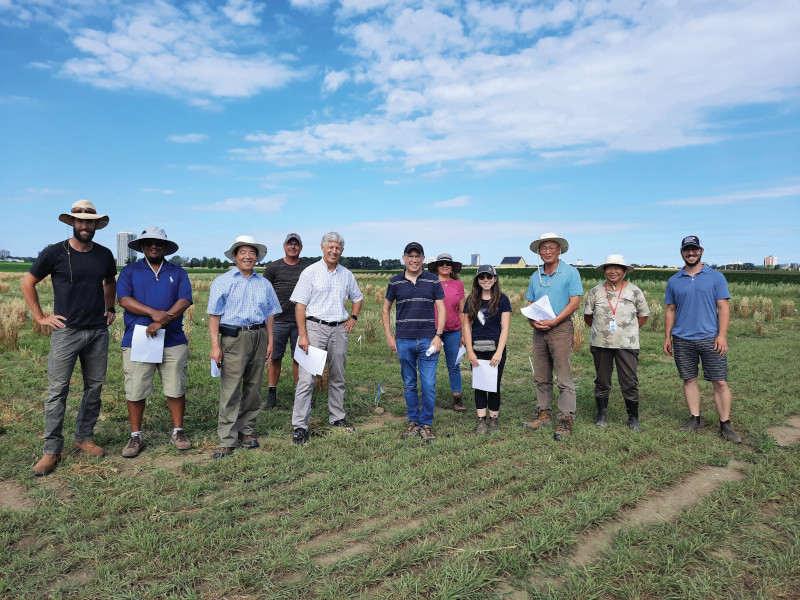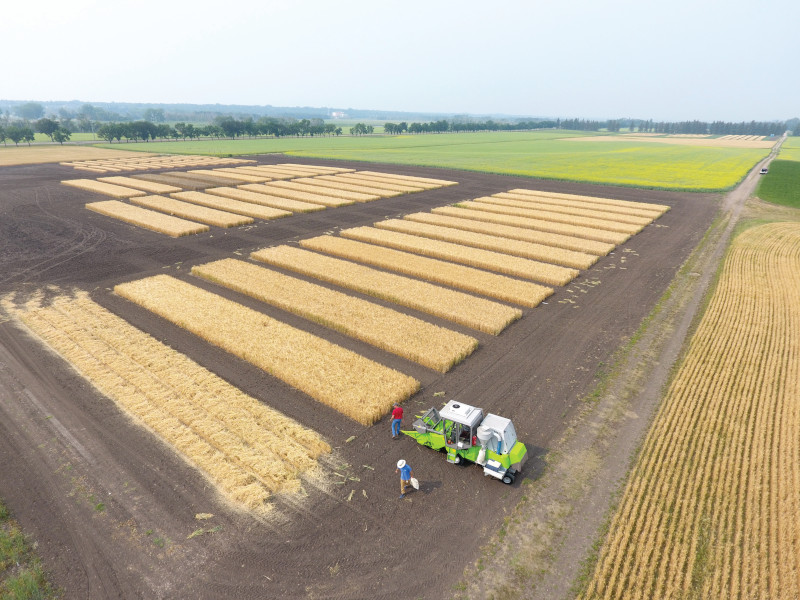PHOTO: Stuart Smyth of the University of Saskatchewan speaks at this week’s Canadian Barley Symposium.
At this week’s 2024 Barley Symposium in Saskatoon, an expert on agricultural innovation said the future of public research in Canada is uncertain — and we need to act sooner rather than later.
For Stuart Smyth, competitiveness isn’t just a buzzword; it’s the lifeline that sustains growth and innovation. But as time goes on, Canada’s cereals sector is becoming less, rather than more competitive — and that’s something that needs to be remedied if we’re going to ensure a healthy future for Canadian agriculture.
At the keynote speaker at the opening day of this week’s Canadian Barley Symposium, the professor in the Department of Agricultural and Resource Economics at the University of Saskatchewan (USask) underscored the paramount importance of competitiveness in securing the necessary resources for investment, labour, and research.
At the same time, he pointed out a troubling trend: Canada trails behind the United States and many other major agricultural players in crop productivity increases.
“Investing in agricultural competitiveness is investing in the future of our food system. Without adequate resources and a keen focus on innovation, we risk falling behind,” Smyth said.
Smyth’s observations align with the broader trends in agricultural innovation and funding. Over the past six decades, innovation has been a driving force behind a staggering increase in global food production, achieved with a mere 10% expansion in land use. However, Smyth raises a red flag regarding R&D funding trends in Canada, noting a decline in private sector investment coupled with stagnant public sector funding.
In Canada, where agricultural innovation should ideally flourish, only a paltry 20% of funds translate into commercialized products when it comes to cereals.
“Effective agricultural research and development require robust investments from both the public and private sectors. Without adequate funding, our capacity for innovation and productivity growth remains constrained,” Smyth remarks.
Challenges in agricultural research and development are further exacerbated by Canada’s productivity and regulatory barriers. Smyth points out the significant hurdles these pose for innovation and R&D initiatives. For instance, private sector involvement in crucial areas like barley and wheat breeding is limited, hindering advancements in disease resistance and frost tolerance.
“In order to truly unlock the potential of our agricultural sector, we must address the regulatory barriers that stifle innovation and progress.”
Recent changes to plant variety protection laws have garnered some positive responses from plant breeders in Canada, with 44% reporting increased incentives to invest in research. However, Smyth acknowledges that regulatory hurdles continue to impede the efficient flow of innovation within the sector.
“To foster a culture of innovation, we need greater clarity on regulatory frameworks and a concerted effort to streamline the innovation pipeline,” Smyth suggests.
Looking ahead, Smyth underscores the necessity of periodic updates to Canada’s R&D pipelines and regulatory systems to remain competitive globally. He stresses the urgency of staying ahead of European competitors in the gene editing technology race, highlighting the immense market potential once regulations ease.
“As we navigate the complexities of agricultural innovation, proactive measures are essential to ensuring Canada remains a key player in the global arena,” Smyth says.
The Public and the Private
Fostering public-private partnerships is essential for driving innovation in the 21st century, he said. Unfortunately, there’s a widespread misconception that collaboration with the private sector undermines the rigour and robustness of research.
“Want to get attacked on social media? Form a public-private partnership,” he said.
However, such partnerships are key to innovation, according to Smyth.
“Take, for instance, the Genome Canada projects, which have thrived for nearly two decades with matching private sector funding. These initiatives have propelled ground-breaking research, demonstrating the value of such partnerships in driving scientific progress,” he said.
“Yet, despite our successes, Canada faces significant challenges in maintaining its competitive edge. Our patentability rankings have slipped, and productivity is on the decline. This downward trend in productivity poses a real threat to our ability to extract maximum value from research and development investments.”
Moreover, Canada’s regulatory landscape presents formidable barriers to innovation, hindering our ability to seize future market opportunities. As it stands, we’re failing to adequately position ourselves for the agricultural markets of tomorrow, according to Smyth.
“A prime example of this is evident in the limited private sector involvement in barley and wheat development. With public sector varieties dominating the market for years, private sector investment dwindles, exacerbating the challenge of sustaining funding for public sector research in the face of budgetary constraints.”
Looking ahead, he said it’s clear that short-term funding strategies are woefully inadequate for the long-term sustainability of agricultural research and development. We need investment strategies that provide certainty and stability, empowering researchers to plan and execute their work effectively.
The Seed Connection
Central to bolstering Canada’s competitiveness is also bolstering the health of its certified seed sector. In his efforts to understand the needs of the certified seed sector and increase the likelihood of licensing new varieties, Smyth’s team at USask has conducted surveys to gauge their preferences.
Nearly half of the respondents expressed a desire for a significant 5% yield increase in new varieties to even consider licensing them. Conversely, varieties with only a marginal 1% yield increase were deemed less desirable for licensing.
Interestingly, disease resistance emerged as a top priority, trumping insect resistance in importance. Additionally, considerations such as maturation dates and frost tolerance were highlighted as crucial factors influencing variety selection.
“However, despite our efforts, a significant portion of invested funds in variety development goes unused due to marginal performance. Approximately 8% of developed varieties never make it into seed guides, resulting in stranded investments of around $3 million. This raises questions about our metrics for success and the efficiency of our innovation pipelines,” he said.
Smyth noted that even with the Canadian Food Inspection Agency’s recently issued new guidance regarding gene editing, a problem still exists: according to the CFIA, a gene edited line that exhibits a trait for herbicide tolerance triggers Canada’s Plant with Novel Traits (PNT) legislation, which brings with it numerous regulatory hurdles, extra time and additional cost.
“The prospect of a variety being labeled a PNT deters breeders, leading to scaled-back research efforts or outright abandonment of promising traits,” he said. “This not only limits the effectiveness and robustness of developed technologies but also stifles innovation in the agricultural sector.”
A major key to remedying the situation is to get more end users on board; if farmers can get a premium for their grain, they will be more likely to adopt new genetics.
Increasingly, the push for sustainability is originating from food producers and processors. They’re demanding quantifiable evidence that demonstrates the sustainability improvements in crops like barley or wheat compared to five years ago, he said.
“For instance, if we can showcase advancements in genetics resulting in better herbicide tolerance, thereby reducing environmental impact by 15%, it encourages greater adoption of these crops,” Smyth added.
However, for this shift towards sustainability to truly take root, there needs to be a tangible benefit for farmers.
“They need to see a direct incentive for adopting these sustainable practices. This could come in the form of premiums offered by food processors to farmers who opt for new barley varieties, for instance, offering an extra dollar per bushel.”
Such incentives encourage farmers to invest in certified seeds and embrace sustainable practices, ultimately benefiting the entire supply chain, from wholesalers to consumers.
“While the food sector rightly emphasizes sustainability, it’s equally important to ensure that these initiatives are financially viable for farmers. It’s about striking a balance between environmental stewardship and economic prosperity within the agricultural ecosystem,” he added.
“By aligning incentives with sustainability goals, we can create a win-win scenario that fosters both environmental conservation and economic viability in agriculture.”













